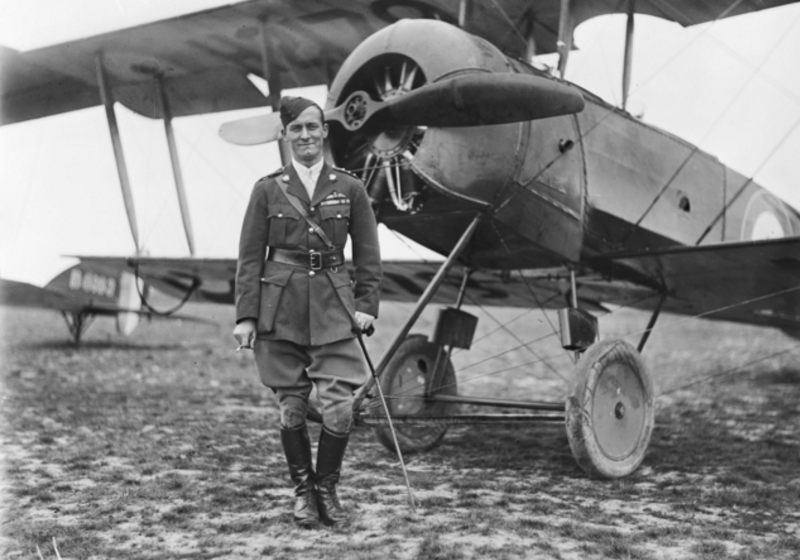The Australian Flying Corps, 1917–18 (part 1)
Posted By Alan Stephens on July 19, 2017 @ 10:01

By 1917, the men of the Australian Flying Corps’ No. 1 Squadron had been fighting in the Middle East for almost two years [1]. Now Australia’s airmen were ready to join the allies’ broader campaign in the Great War.
Because Europe was the main theatre, the next three AFC squadrons to be raised—Nos. 2, 3 and 4—were designated for the Western Front. They arrived in England for additional training between late 1916 and early 1917. Supplementary courses for aircrew and mechanics were conducted at a number of English military depots and civilian institutions (including Oxford University), and covered such subjects as rigging, engines, weapons and wirelesses. Four AFC training squadrons were then established in England: Nos. 5, 6, 7 and 8.
Flying training was a dangerous business. Royal Flying Corps (RFC) statistics show that on average every trainee destroyed six undercarriages and wrecked two aircraft ‘completely’. Arthur ‘Harry’ Cobby and George Jones, who were to become major figures in Australian aviation history, both crashed in England and were lucky not to have been killed. By the end of the war, there were 25 Australian graves in the cemetery near the training base at Leighterton in Gloucestershire.
No. 2 Squadron was the first AFC unit to arrive on the Western Front, where it was integrated into the RFC. Brilliantly led by Major Oswald Watt, the squadron distinguished itself on the first day of the Battle of Cambrai on 20 November 1917. Flying their DH5s only metres above the trenches because of heavy fog, the Australian pilots bombed and strafed enemy troops, gun batteries, fortifications and supply trains. By the end of the day, six of the squadron’s 18 aircraft had been shot down and another was missing. When the battle was at its fiercest, the squadron was visited by the commander of the RFC on the front, Major-General Hugh Trenchard, who described the Australians as ‘really magnificent’.
Nos. 3 and 4 Squadrons arrived in France shortly afterwards, the latter allocated to fighter and attack tasks, the former to reconnaissance and army liaison. Because of their artillery spotting and photographic roles, No. 3 Squadron’s RE8s were prime targets for German fighters, often being attacked by as many as 12 aircraft. Despite the RE8’s modest performance, the Australian pilots and observers managed to shoot down 51 enemy aircraft, a remarkable achievement.
No. 4 Squadron was to become the AFC’s most successful fighter unit in terms of enemy aircraft destroyed, claiming 199 kills to No. 2 Squadron’s 185. That slender margin may have been due in part to No. 4 Squadron’s having been equipped from the outset with one of the war’s outstanding fighters, the Sopwith Camel, whereas No. 2 Squadron had to make do with DH5s until rearmed with SE5as after the Battle of Cambrai. No. 4 Squadron also benefited from having in its ranks the AFC’s two leading aces, captains Cobby and E.J.K. McCloughry.
Harry Cobby was the archetypal fighter pilot: courageous, dashing and good-humoured. A bank clerk from Prahran, he joined the AFC in 1917 and by the end of the year was in France. He scored his first kill on 4 February 1918; and on 20 March he and another pilot intercepted five aircraft from von Richthofen’s Flying Circus and shot down three. In a brief period in July, Cobby scored double victories on the 9th and 14th, and four kills on the 19th. In between those dogfights, Cobby, like his colleagues, strafed and bombed German trenches and supply lines.
On one occasion while patrolling alone Cobby was attacked by 16 Fokkers. With his guns jammed, he threw his Camel into a series of desperate manoeuvres that enabled him to break away and escape by hedge-hopping back to allied lines. His aircraft was so badly shot up that when he landed it split apart, leaving him unconscious but unscathed. Another time, his seat was shot out from under him and he had to fly home holding on to the fuselage to save himself from falling out. Once he landed his Camel in the middle of the Australian lines and, still dressed in flying helmet and boots, rode the winner of an impromptu horserace the diggers were holding. He then took off and resumed his patrol.
By the end of his tour, Cobby’s reputation was such that he was leading formations of up to 80 allied aircraft. He finished the war as the AFC’s top ace and a national hero, having shot down 29 aircraft and 13 balloons.
Article printed from The Strategist: https://www.aspistrategist.org.au
URL to article: https://www.aspistrategist.org.au/australian-flying-corps-1917-18-part-1/
URLs in this post:
[1] fighting in the Middle East for almost two years: https://www.aspistrategist.org.au/australias-great-war-air/
Click here to print.